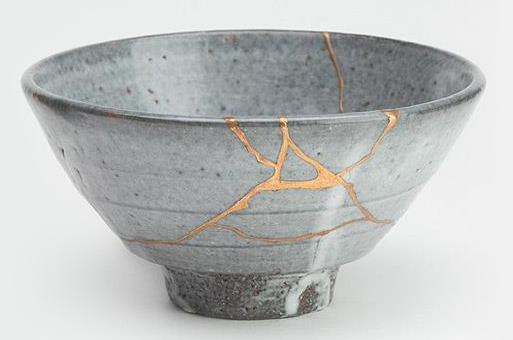The traditional Japanese art of kintsugi supposedly originated in the 15th century, when shogun Ashikaga Yoshimasa sent a broken bowl to Chinese craftsmen in hopes for its repair. When the bowl returned to him from China, he was dismayed to find it awkwardly put together with… staples. Large, bulky staples, which frankly did not improve on its once broken state. Frustrated, Yoshimasa prompted Japanese craftsmen to search for a more “aesthetically pleasing” (and probably more sustainable) method of repairing ceramics. The art of kintsugi rose so much in popularity that it was said some purposefully broke dishes, just to repair it back in this way.

The word kintsugi, when taken apart translates to “golden” (from kin) and “joining” (from tsugi). Similar to maki-e technique, lacquer is dusted with a gold, silver, or platinum powder to hold as glue for broken pieces of ceramics. Essentially, the cracks of a broken dish are illuminated in metallics, with no attempt of hiding these flaws.

The craft of kintsugi follows closely with the japanese philosophy of wabi-sabi. To put it roughly, wabi sabi is an aesthetic, as well as a world view that places beauty in the imperfect. Wabi Sabi values an object more after having been broken than if it had only stayed in its “pure” state. Countering western ideals of symmetry and perfection, kintsugi treats breakage as part of an object’s history, rather than as something to disguise. The symbolism in kintsugi is a powerful one because it can be understood universally — despite its specific Japanese origin.
More than just ceramic reparation, kintsugi reminds us that it is okay (and necessary, even) to embrace your own cracks and flaws. Your off-centered freckle, your laughter that rings a little too loudly, your incessant coffee drinking… the list in your head needs no help in continuing. Kintsugi implies that these oddities are what makes yourself more wholesome, more honest and beautiful. It teaches us to embrace the strains put on us in each struggle, in each pitfall, and see that we are stronger and wiser after the wear and tear.

